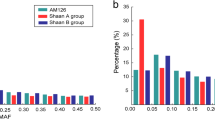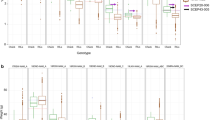Abstract
Association mapping (AM) is a powerful approach to dissect the genetic architecture of quantitative traits. The main goal of our study was to empirically compare several statistical methods of AM using data of an elite maize breeding program with respect to QTL detection power and possibility to correct for population stratification. These models were based on the inclusion of cofactors (Model A), cofactors and population effect (Model B), and SNP effects nested within populations (Model C). A total of 930 testcross progenies of an elite maize breeding population were field-evaluated for grain yield and grain moisture in multi-location trials and fingerprinted with 425 SNP markers. For grain yield, population stratification was effectively controlled by Model A. For grain moisture with a high ratio of variance among versus within populations, Model B should be applied in order to avoid potential false positives. Model C revealed large differences among allele substitution effects for trait-associated SNPs across multiple plant breeding populations. This heterogeneous SNP allele substitution effects have a severe impact for genomic selection studies, where SNP effects are often assumed to be independent of the genetic background.





Similar content being viewed by others
References
Bernardo R, Yu J (2007) Prospects for genome-wide selection for quantitative traits in maize. Crop Sci 47:1082–1090
Blanc G, Charcosset A, Mangin B, Gallais A, Moreau L (2006) Connected populations for detecting quantitative trait loci and testing for epistasis: an application in maize. Theor Appl Genet 113:206–224
Calus MPL, Meuwissen THE, De Roos APW, Veerkamp RF (2008) Accuracy of genomic selection using different methods to define haplotypes. Genetics 178:553–561
De Los Campos G, Naya H, Gianola D, Crossa J, Legarra A, Manfredi E, Weigel K, Cotes JM (2009) Predicting quantitative traits with regression models for dense molecular markers and pedigrees. Genetics 182:375–385
Dellaporta SL, Wood J, Hicks JB (1983) A plant DNA mini-preparation version II. Plant Mol Biol Rep 1:19–21
Falconer DS, Mackay TFC (1996) Introduction to quantitative genetics, 4th edn. Longman House, London
Flint-Garcia SA, Thornsberry JM, Buckler ES (2003) Structure of linkage disequilibrium in plants. Annu Rev Plant Biol 54:357–374
Frascaroli E, Cane` MA, Pe` ME, Pea G, Morgante M, Landi P (2009) QTL detection in maize testcross progenies as affected by related and unrelated testers. Theor Appl Genet 118:993–1004
Gianola D, Fernando RL, Stella A (2006) Genomic assisted prediction of genetic value with semi-parametric procedures. Genetics 173:1761–1776
Gower JC (1966) Some distance properties of latent root and vector methods used in multivariate analysis. Biometrika 53:325–338
Habier D, Fernando RL, Dekkers JCM (2007) The impact of genetic relationship information on genome-assisted breeding values. Genetics 177:2389–2397
Habier D, Totir LR, Fernando RL (2010) A Two-stage approximation for analysis of mixture genetic models in large pedigrees. Genetics 185:655–670
Hill WG, Robertson A (1968) Linkage disequilibrium in finite populations. Theor Appl Genet 38:226–231
Holm S (1979) A simple sequentially rejective multiple test procedure. Scand J Stat 6:65–70
Jansen RC, Stam P (1994) High resolution of quantitative traits into multiple loci via interval mapping. Genetics 136:1447–1455
Kosambi D (1944) The estimation of map distance from recombination values. Ann Eugen 12:172–175
Kover PX, Valdar W, Trakalo J, Scarcelli N, Ehrenreich IM, Purugganan MD, Durrant C, Mott R (2009) A multiparent advanced generation inter-cross to fine-map quantitative traits in Arabidopsis thaliana. PLoS Genet 5:e1000551
Lu Y, Zhang S, Shah T, Xie C, Hao Z, Li X, Farkhari M, Ribaut J-M, Cao M, Rong T, Xu Y (2010) Joint linkage–linkage disequilibrium mapping is a powerful approach to detecting quantitative trait loci underlying drought tolerance in maize. Proc Natl Acad Sci USA 107:19585–19590
Luan T, Woolliams JA, Lien S, Kent M, Svendsen M, Meuwissen TH (2009) The accuracy of genomic selection in Norwegian red cattle assessed by cross-validation. Genetics 183:1119–1126
Maurer HP, Melchinger AE, Frisch M (2008) Population genetic simulation and data analysis with Plabsoft. Euphytica 161:133–139
McMullen MD, Kresovich S, Villeda HS, Bradbury P, Li HH, Sun Q, Flint-Garcia S, Thornsberry J, Acharya C, Bottoms C, Brown P, Browne C, Eller M, Guill K, Harjes C, Kroon D, Lepak N, Mitchell SE, Peterson B, Pressoir G, Romero S, Rosas MO, Salvo S, Yates H, Hanson M, Jones E, Smith S, Glaubitz JC, Goodman M, Ware D, Holland JB, Buckler ES (2009) Genetic properties of the maize nested association mapping population. Science 325:737–740
Melchinger AE, Utz HF, Schön CC (1998) Quantitative trait locus (QTL) mapping using different testers and independent population samples in maize reveals low power of QTL detection and larger bias in estimates of QTL effects. Genetics 149:383–403
Meuwissen THE, Hayes BJ, Goddard ME (2001) Prediction of total genetic value using genome-wide dense marker maps. Genetics 157:1819–1829
Mihaljevic M, Friedrich UH, Melchinger AE (2004) Congruency of quantitative trait loci detected for agronomic traits in testcrosses of five populations of European maize. Crop Sci 44:114–124
Myles S, Peiffer J, Brown PJ, Ersoz ES, Zhang Z, Costich DE, Buckler ES (2009) Association mapping: critical considerations shift from genotyping to experimental design. Plant Cell 21:2194–2202
R Development Core Team (2010) R: A language and environment for statistical computing, R Foundation for Statistical Computing. http://www.R-project.org
Rafalski JA (2002) Novel genetic mapping tools in plants: SNPs and LD-based approaches. Plant Sci 162:329–333
Reif JC, Hamrit S, Heckenberger M, Schipprack W, Maurer HP, Bohn M, Melchinger AE (2005) Temporal trend of genetic diversity in European maize germplasm. Theor Appl Genet 111:838–845
Reif JC, Liu W, Gowda M, Maurer HP, Möhring J, Fischer S, Schechert A, Würschum T (2010) Genetic basis of agronomically important traits in sugar beet (Beta vulgaris L.) investigated with joint linkage association mapping. Theor Appl Genet 121:1489–1499
SAS Institute Inc (2008) SAS/STAT® 9.2 User’s Guide. Cary, NC, USA
Schön CC, Utz HF, Groh S, Truberg B, Openshaw S, Melchinger AE (2004) Quantitative trait locus mapping based on resampling in a vast maize testcross experiment and its relevance to quantitative genetics for complex traits. Genetics 167:485–498
Schön CC, Dhillon BS, Utz HF, Melchinger AE (2010) High congruency of QTL positions for heterosis of grain yield in three crosses of maize. Theor Appl Genet 120:321–332
Schwarz G (1978) Estimating the dimension of a model. Ann Stat 6:461–464
Searle SR (1971) Linear models. Wiley, New York
Smalley MD, Daub JL, Hallauer AR (2004) Estimation of heritability in maize by parent-offspring regression. Maydica 49:221–229
Stam P (1993) Construction of integrated genetic linkage maps by means of a new computer package: JoinMap. The Plant J 3:739–744
Stich B, Melchinger AE, Frisch M, Maurer HP, Heckenberger M, Reif JC (2005) Linkage disequilibrium in European elite maize germplasm investigated with SSRs. Theor Appl Genet 111:723–730
Stich B, Mohring J, Piepho H-P, Heckenberger M, Buckler ES, Melchinger AE (2008) Comparison of mixed-model approaches for association mapping. Genetics 178:1745–1754
Utz HF, Melchinger AE, Schön CC (2000) Bias and sampling error of the estimated proportion of genotypic variance explained by quantitative trait loci determined from experimental data in maize using cross validation and validation with independent samples. Genetics 154:1839–1849
Van Inghelandt D, Reif JC, Dhillon BS, Flament P, Melchinger AE (2011) Extent and genome-wide distribution of linkage disequilibrium in commercial maize germplasm. Theor Appl Genet. doi: 10.1007/s00122-011-1562-3
Van Ooijen JW, Voorrips RE (2001) JoinMap 3.0 software for the calculation of genetic linkage maps. Plant Res Int, Wageningen
Wright S (1978) Evolution and genetics of populations, variability within and among natural populations, 4th edn. The University of Chicago Press, Chicago, p 91
Wu R, Ma C-X, Casella G (2002) Joint linkage and linkage disequilibrium mapping of quantitative trait loci in natural populations. Genetics 160:779–792
Yan JB, Shah T, Warburton M, Buckler ES, McMullen MD, Crouch J (2009) Genetic characterization of a global maize collection using SNP markers. PLoS ONE 4:e8451
Yu J, Buckler ES (2006) Genetic association mapping and genome organization of maize. Curr Opin Biotech 17:155–160
Yu J, Holland JB, McMullen MD, Buckler ES (2008) Genetic design and statistical power of nested association mapping in maize. Genetics 178:539–551
Zeng ZB (1994) Precision mapping of quantitative trait loci. Genetics 136:1457–1468
Zhang Z, Ersoz E, Lai C-Q, Todhunter RJ, Tiwari HK, Gore MA, Bradbury PJ, Yu J, Arnett DK, Ordovas JM, Buckler ES (2010) Mixed linear model approach adapted for genome-wide association studies. Nat Genet 42:355–363
Acknowledgments
We would like to thank Dr. Raffaele Capitanio from Syngenta Seeds for providing the information on phenotypic data. This research was conducted within the Biometric and Bioinformatic Tools for Genomics based Plant Breeding project supported by the German Federal Ministry of Education and Research (BMBF) within the framework of GABI–FUTURE initiative. We thank two anonymous reviewers for their valuable suggestions, which considerably improved the manuscript.
Author information
Authors and Affiliations
Corresponding author
Additional information
Communicated by J. Yan.
Electronic supplementary material
Below is the link to the electronic supplementary material.
Rights and permissions
About this article
Cite this article
Liu, W., Gowda, M., Steinhoff, J. et al. Association mapping in an elite maize breeding population. Theor Appl Genet 123, 847–858 (2011). https://doi.org/10.1007/s00122-011-1631-7
Received:
Accepted:
Published:
Issue Date:
DOI: https://doi.org/10.1007/s00122-011-1631-7




